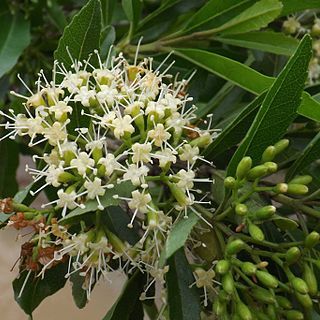Leaves opposite, less often subopposite, or occasionally alternate, petiolate; petiole glabrous or hairy as the branchlets, 2–12 mm. long; lamina not much paler beneath and subcoriaceous or coriaceous when dry, narrowly to very narrowly elliptic, (2–)4–8 x as long as wide, (1·5)3–13 x 0·4–3(5) cm., obtuse or rounded and often mucronulate at the apex, cuneate at the base or decurrent into the petiole, bluntly serrate to entire, glabrous or with minute glandular hairs on both sides; secondary veins not very conspicuous.
Trees or shrubs to 12 m. tall; bark (reddish) brown.. Lamina of leaves narrowly elliptic, up to 12 cm. long, 2.6 cm. wide, attenuating to a small rounded and often mucronulate apex, cuneate or narrowly cuneate at the base, bluntly serrate, ± sinuate or more rarely entire, glabrous.. Inflorescences terminal and lateral, glabrous.. Calyx 4–5 mm. long; lobes cleanly dividing.. Corolla-lobes rounded above, glabrous.. Ovary hirsute, at least above.. Fruit scarcely exceeding the calyx, hirsute.
Corolla white, creamy, or sometimes pale lilac, outside with some minute glandular hairs at the base of the lobes, inside with a villose ring of recurved hairs in the throat and with minute glandular hairs in the tube except for its glabrous base; tube slightly shorter or less often slightly longer than the calyx; lobes oblong, 1·5–3 x as long as wide, 1·8–3 x 0·8–2 mm., obtuse or rounded at the apex.
Calyx green, 3·5–5 x 1·2–2 mm., minutely pubescent with glandular and often also ordinary hairs outside, when dry seemingly glabrous and often shining, inside sericeous; tube 4–8 x as long as the lobes; lobes triangular, about as long as wide or wider, 0·5–1·2(1·4) x 0·7–1·2 mm., acute or subacute, entire, sometimes two coherent or partially united.
Shrub or tree, 2-7 m high. Leaves opposite, linear-oblong to oblanceolate-oblong, usually shallowly re-pand dentate, 45-90 x 4-15 mm. Cymes 3-flowered, inflorescence usually broader than long, often overtopped by leaves. Flowers white.
Inflorescence rather congested, 1·5–7 x 2–8 cm., 2–5 x branched. Peduncle, branches, and pedicels glabrous or scarcely hairy. Ultimate branches and pedicels very short or obsolete.
Pistil: ovary obcordoid or ovoid, slightly laterally compressed, 1–1·6 x 0·8–1·2 x 0·7–1 mm., appressed–pubescent, glabrous at the base.
Branchlets glabrous or sparingly and minutely puberulous, not lenticellate, slightly angular and often sulcate when dry.
Evergreen shrub or small tree, 1–15(20) m. high, often gnarled and willow–like, sometimes straggling.
Bark reddish–brown, smooth or shallowly and longitudinally fissured.
Capsule about as long as the calyx, appressed–pubescent.
Trunk often rather fluted, 10–60 cm. in diam.
Flower slightly fragrant, 1–3(8) together.
Stamens: anthers about 1·2 mm. long.
Seeds 0·5–0·8 x 0·15–0·2 mm.


